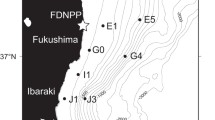Abstract
WE have noted with interest recent reports which suggest a preferential biological availability of 238Pu over 239+240Pu in terrestrial and aquatic organisms1–4. Although kinetic isotope effects do occur in biological systems for low mass number elements (H, C, N), such effects are generally discounted as the mass number of the element increases. Thus, differential biological availability of isotopes of high mass number elements, such as plutonium, would normally be attributed to differences in the chemical or physical forms of the isotopes or to the different weights of isotope available to organisms as a result of large differences in their specific activities. These arguments have indeed been used to explain differential plutonium isotope behaviour in animals in controlled laboratory conditions5–7. It is not certain, however, that the same arguments can be used to explain anomalies of plutonium isotope behaviour in organisms contaminated by nuclear test debris or by wastes from nuclear fuel reprocessing plants. Plutonium activity levels, while easily measurable, do not approach those generally used in laboratory studies. In addition, geochemical weathering could conceivably alter any original differences in physical or chemical form of the plutonium. We report here the results of experiments which show that deposit-feeding marine worms living in sediments contaminated with plutonium isotopes in different ways do not preferentially accumulate 238Pu over 239+240Pu. This is particularly significant in that the worms held in sediments contaminated in the natural environment may have been exposed to different chemical and physical forms of plutonium isotopes.
Similar content being viewed by others
References
Volchok, H. L., et al., in Assessing Potential Ocean Pollutants, 27–63 (National Academy of Sciences, Washington DC, 1975).
Hakonson, T. E., and Johnson, L. J., LA-UR-73-1291, 1–6 (Los Alamos Scientific Laboratory, 1973).
Emery, R. M., Klopher, D. C., and Weimer, W. C., BNWL-1867, UC-48, 1–76 (Battelle Pacific North-west Laboratory, 1974).
Emery, R. M., and Garland, T. R., BNWL-1879, UC-48, 1–26 (Battelle Pacific North-west Laboratory, 1974).
Thompson, R. C., in Plutonium Handbook: A Guide to the Technology (edit. by Wick, O. J.), 785–829 (Gordon and Breach, New York, 1967).
Mahlum, D. D., and Sikov, M. R., Hlth Phys., 17, 346–347 (1969).
Bair, W. J., Willard, D. H., Nelson, I. C., and Case, A. C., Hlth Phys., 27, 392–396 (1974).
Noshkin, V. E., Bowen, V. T., Wong, K. M., and Burke, J. C., in Proc. third natn. Symp. Radioecol, CONF-710501-P2, 681–688 (1971).
Beasley, T. M., and Fowler, S. W., in Acct int. Lab. mar. Radoiact. Tech. Rep., Monaco (in the press).
Author information
Authors and Affiliations
Rights and permissions
About this article
Cite this article
BEASLEY, T., FOWLER, S. Plutonium isotope ratios in polychaete worms. Nature 262, 813–814 (1976). https://doi.org/10.1038/262813a0
Received:
Accepted:
Published:
Issue Date:
DOI: https://doi.org/10.1038/262813a0
- Springer Nature Limited
This article is cited by
-
Plutonium and americium in fish
Nature (1977)





